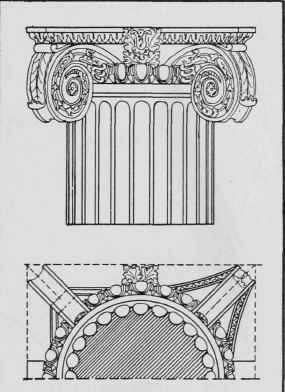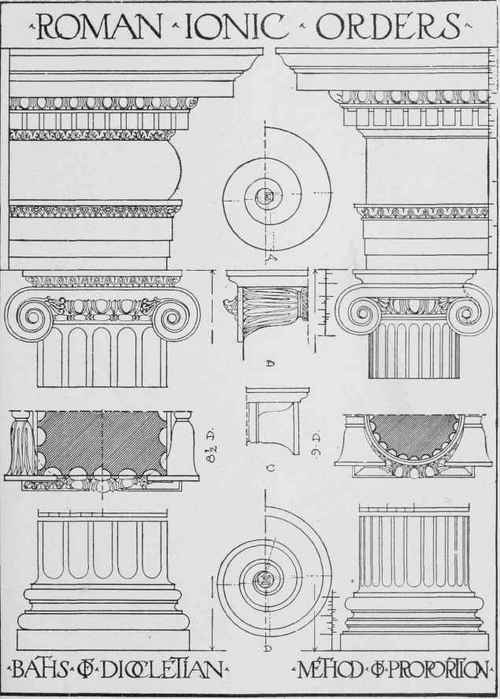Classic Roman Ionic. Development And Use Of The Order
Description
This section is from the book "Cyclopedia Of Architecture, Carpentry, And Building", by James C. et al. Also available from Amazon: Cyclopedia Of Architecture, Carpentry And Building.
Classic Roman Ionic. Development And Use Of The Order
There are comparatively few remains of Roman buildings where the Ionic Order was originally used. Among the Romans this Order certainly never met with the favor accorded to it by the Greeks. At the same time, the great number of antique Ionic capitals used in the naves of Roman Basilicas of later date, indicate that at one time this Order must have been employed to a considerable extent-probably in the early Forums that were afterwards destroyed to make room for later buildings. The Roman columns, being generally monoliths of marble or other beautiful material, instead of being shafts composed of various small sections after the Greek fashion, were sufficiently valuable to be saved and used again in the newer work that was to take the place of that torn down. The capitals may have been used a second time with the columns to which they belonged, or they may have been transposed and used with other columns. As a consequence, in many Roman churches, frequently neither the column shafts nor the capitals exactly match in either color, material, design, or workmanship, often being obviously of different dates and taken from different buildings.

SCAMOZZI CAPITAL Fig. 120.
In the Roman colonies and in Syria, the Ionic Order seems to have been employed longer than in Rome itself, possibly because of the difficulty of carving the elaborate Corinthian capital which had later so much vogue. Examples of the Ionic capital carrying the canted volute on the angle, are very rare. At the large size in which this Order was employed by the Romans, the awkwardness of this angular treatment of the Ionic Capital undoubtedly became more apparent, and for this reason they may have avoided its use whenever it was possible. When, during the Renaissance, an Ionic capital with the angular volute treatment on the four corners came into general use, it was called the "Scamozzi" capital, after the architect who first most frequently employed it, for the purpose of distinguishing it from the more usual Classic form. The actual treatment of this capital as used by Scamozzi himself is shown in Fig. 120.

Fig. 121.
The earlier Roman Ionic Orders were evidently made by Greek workmen; and the capital from Pompeii shown in Fig. 121 clearly evidences this fact. In this example-that of an attached column-a rather interesting treatment of the volute on the angle is shown. Seen from the front, the volute is canted after the same fashion as it would be in order to make all four-or in this case, three-elevations of the capital agree; but on the end the roll is still employed, although treated in a somewhat free manner.
The Base. The base of the column shafts of the Ionic Order interior of Church of San Stefano, Rome; the Rotunda (Fifth Century).

Showing the utilization of various forms of older Roman column shafts and Ionic capitals.
(Note the two differently proportioned but exceptionany well cut and preserved Roman Corinthian capitals).
offer little dissimilarity in treatment. This is very clearly shown in Fig. 122, in which A is from the Theater of Marcellus, and B from the Baths of Diocletian, both Classic examples, while C and D are taken from the columns of Palladio and Vignola. It will be observed that the form given by Vignola is rather an exceptional one, the general type being more nearly that shown by Palladio.
The Capital. The capital of the Roman Ionic column is fashioned after the same general manner as that described in detail in the Greek Ionic Order, but the mouldings are not so finely cut. The shaft was never given a necking, such as the Greeks, and later, some of the Renaissance architects, occasionally employed. It will also be noticed that the volute or spiral of the Roman Order is much less refined than in the Greek examples. It contains, moreover, fewer spirals on the face. Whether this paucity of spirals was occasioned by a lack of skill in the carver, or whether-as in the case of the use of the spiral in the Theater of Marcellus, on the second story-it was because these details were somewhat removed from the eye and therefore this simplification was to be preferred in the judgment of the builders, we do not know.

Fig. 122.
Fortunately the volute of the Romans is much more easily reduced to a rule than that of the Greeks. The Roman volute may have been laid out with compasses, while the Greek volute was certainly laid out in no such simple fashion. It has been suggested that, in the Greek Doric capital, the volute eye was filled with a round wooden plug, and that a string fastened to this and wound up around it would produce the concentric circles of the volute faces.
The Entablature. The architrave and frieze of the entablature

Fig. 123. Temple of Fortuna Virilis, Rome.

THE PALAZZO MEDICI (R1CCARDI., FLORENCE, ITALY.
Michelozzo Michelozzi, Architect,
The Private Palace of the Fifteenth Century. Note the Different Kinds of Masonry in the Different Storks. The Column is Used only for Decorative Purposes In the Window Mullions of the Upper Stories of the Roman Order is in the main similar to the Greek; but the cornice, in the general proportions and details of its mouldings, more nearly approaches that used with the earlier Corinthian column of the Greeks. The frieze is often elaborately carved, as in the Temple of Fortuna Virilis, Fig. 123.
Examples. It is unfortunate that the continual tearing down of early Roman work, to which we have already referred, in order that successive Emperors might erect buildings in the locations already occupied by the structures of their predecessors, should have destroyed for us practically all the early architecture of the city of Rome. The result is, that, for examples of the Ionic Order, we are restricted to the two buildings w h i c h have already furnished us with a Doric column on the first story, and one other example-and that a very fine one-in the Temple of Fortuna Virilis, where fluted shafts are employed in the engaged columns which decorate the walls of the cella.
Fortunately we are able to indicate the chronological order in which these few examples were erected. The Temple of Fortuna Virilis, possibly of Greek workmanship, dates from the early part of the first century B. C., being probably erected before the arcade of the Tabularium. The Theater of Marcellus, 23 B. C, and the Colosseum, 72 A. D., followed. In one other Roman building, the Temple of Saturn, was the Ionic Order used, although here it is of a rather debased type.

Fig. 124.

Fig. 125.
The capita] from the Temple of Fortuna Virilis, as shown in Fig. 124, sufficiently displays the character of its cutting and the general "stubby" effect of the entire cap. The entablature used on this temple is rather crude in type, and is therefore not illustrated. The Roman Ionic cap shown in the upper part of the same figure, is a much more interesting, if later and more elaborate, example, and its general lines are more worthy of being copied. The examples of the Colosseum and the Theater of Marcellus. are also to be considered as special uses of superimposed and engaged Orders on the second stories of these buildings. Of the two, that on the Theater of Marcellus is much the better, as it has been more carefully studied in proportion and detail as well as in relation to its position and to the entire building, than that on the Colosseum. This Order is shown in Fig. 125. The Order shown in Plate LI, on the left of the plate, is the pilaster used in the Baths of Diocletian at Rome, and is interesting for the proportions of its entablature, although tins entablature is too fine in scale for the treatment of the column itself., where the coarse fluting and heavy cutting of the cap and base would ordinarily suggest a heavier and much less finely moulded crowning member. On this plate, at the right, is also shown a simple system of proportioning the Roman Ionic Order that should prove valuable in redrawing or reproducing a column of this general type. The Roman Ionic Order drawn in Plate XIII, Part I, shows on a larger scale the entablature and capital according to Vignola, and was supposedly adapted by him from the second-story Order of the Theater of Marcellus, perhaps the most beautiful example of antiquity. This plate should be compared with Fig. 125, in which the actual Order from the Theater of Marcellus is shown.

PLATE LI. (A reproduction at small size of Portfolio Plate LI).
The Roman Ionic Order shown by Palladio is given in Plate XIV, Part I, and should be compared with that given in Plate XIII, Part I. Its special value lies in the fact that it shows a cornice with modillions, which in modern practice it is frequently desirable to use with an Ionic column; and a precedent for the proportions of the entablature when used in this way, it is sometimes difficult to find.
Continue to:


